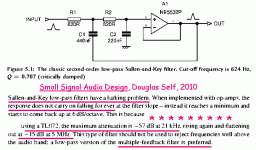My soldering skills don't really lend themselves to surface mount - but I do agree that low pass filtering at the input is ideal. My circuit will include bandpass filtering but wasn't included in the crossover simulation.
I have about 160+ SE5532's & a handful of SE5534's - so I guess they will be used.
I have about 160+ SE5532's & a handful of SE5534's - so I guess they will be used.
... same leveling out then rising characteristic, but surprisingly not at a very much higher frequency....
...happens with Sallen Key...Other topologies, like MFB, do not...
The rise is inherent in the topology; reasonable change of opamp makes little difference. A super-duper output stage combined with high impedance filter parts is some better, not a heap.
My sim suggests the rise is 6dB/oct on a 12dB/oct filter. "Therefore"(?) you can re-design each 2-pole unit as a 3-pole, first pole passive. Before electric computers this was a lot of work; today no big deal. That won't keep the slope down to infinity but at least you can null the rise. Also if the S-K filter is "OK" to a decade above the intended corner, multiple passive poles can be added with only small "error" of alignment.
Charlie's point is on-topic. Sallen-Key is not the only way.
The capacitor 2C feeds forward the input signal to the output and it rises because of the rising output impedance of the opamp at those frequencies.
But do not worry, the inductivity of the speaker or even the wires will attenuate 1st order style and keep the feedthrough constant not rising. This also happens on the lowpass only, the woofer won't output anything even if you could hear it.
But do not worry, the inductivity of the speaker or even the wires will attenuate 1st order style and keep the feedthrough constant not rising. This also happens on the lowpass only, the woofer won't output anything even if you could hear it.
To put things in perspective, my active crossover low pass section uses an FDNR and it runs out of steam at about -80db and it hasn't bothered me in listening at all 🙂 (it did bother me before I finally just accepted it and started to listen to it)
Tony.
Tony.
